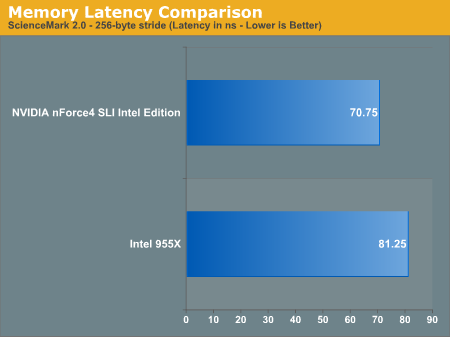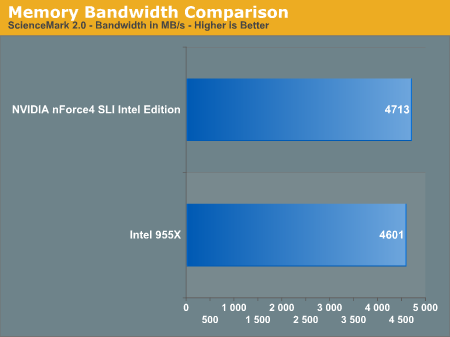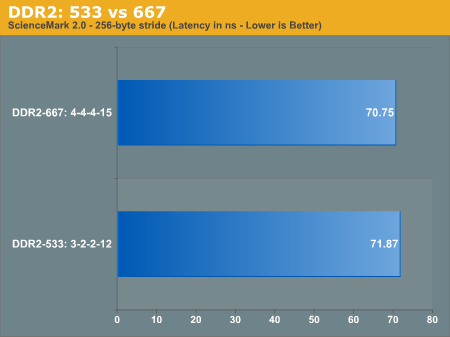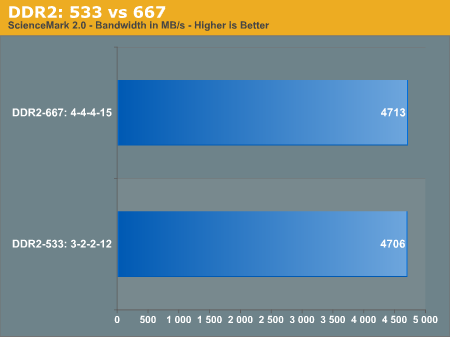Dual Core Intel Platform Shootout - NVIDIA nForce4 vs. Intel 955X
by Anand Lal Shimpi on April 14, 2005 1:01 PM EST- Posted in
- CPUs
Memory Performance
The biggest question on our minds when comparing these two heavyweights was: who has the better memory controller? We turned to the final version of ScienceMark 2.0 for the answer.

Amazingly enough, at the same memory timings, NVIDIA drops memory latency by around 13%. This is a worst case scenario for memory latency. In all of our other memory tests, the nForce4's memory controller was equal to Intel's controller - but even any advantage here is impressive, not to mention such a large advantage.

NVIDIA's latency reduction and DASP algorithms offer a negligible 2% increase in overall memory bandwidth. While you'd be hard pressed to find any noticeable examples of these performance improvements, the important thing here is that NVIDIA's memory controller appears to be just as good as, if not faster, than Intel's best. Kudos to NVIDIA - they have at least started off on the right foot with performance.
DDR2-667 or 533?
When Intel sent us their 955X platform, they configured it with DDR2-667 memory running at 5-5-5-15 timings. NVIDIA sent their nForce4 SLI Intel Edition board paired with some Corsair DIMMs running at 4-4-4-15 timings at DDR2-667. Given that we have lower latency DDR2-533 memory, we decided to find out if there was any real performance difference between DDR2-667 at relatively high timings and DDR2-533 at more aggressive timings. Once again, ScienceMark 2.0 is our tool of choice:

Here, we see that even at 3-2-2-12, DDR2-533 isn't actually any faster than DDR2-667.

...and it offers slightly less memory bandwidth.
It looks like there's not much point in worrying about low latency DDR2-533, as higher latency DDR2-667 seems to work just as well (if not a little better) on the newest Intel platforms.










96 Comments
View All Comments
stevty2889 - Saturday, April 16, 2005 - link
PeteRoy - Saturday, April 16, 2005 - link
Stevty, if you really work for Intel you would know that Intel has a specification for what case to use with 3ghz/90nm processors.Here's a link:
http://support.intel.com/support/processors/pentiu...
stevty2889 - Saturday, April 16, 2005 - link
I think Questar is cramitpals nemisis..Quester I work for Intel, even Intel knows that the prescott has heat issues, and that for most applications right now, AMD is winning in price/performance...having to use water cooling to get a chip to run at stock speed without throttling is a pretty major heat issue if you ask me..even a thermalright XP-120 couldn't keep my 3.4 prescott from throttling at stock speeds, my 3.2 ES, and 2.8 didn't have as much of an issue, but some of the prescotts are running WAY too hot..
stephenbrooks - Friday, April 15, 2005 - link
^^ I was just searching all the previous 81 comments for the word "Soviet" in disbelief. Guess we've spoiled it now though.Houdani - Friday, April 15, 2005 - link
Anyone else miss the days of only bickering about:"The message is clear..."
"First!"
"In Soviet Russia..."
Ah, memories. Feels like only yesterday.
fitten - Friday, April 15, 2005 - link
Well... it would be pretty stupid of a company to not roll with the punches. I'd rather see them shape their direction as they have that be rigid (which means they wouldn't compete anymore).The reason no one jumped at 64bits in x86 land is because the volume of 64bit processors out there wasn't worth the effort. So... 100,000 64bit systems are out there... compare that with over 1000X that number of 32bit only systems. Which would you target if you were developing software? Now that 64bit will be mainstream, the market will move that way.
In addition, mom/pop won't see any real benefit from 64bit. There will be marginal speed benefits to having more general purpose registers, but that would have been the case in 32bit land. I doubt they are doing things that require more than 4G of memory, either. The only other real speed benefits are when you are manipulating 64bit integers and there just aren't that many apps that mom/pop use that need that kind of range.
I like AMD as well (all 5 of my personal desktops have them) but I'm not a blind follower. It's nice to be excited about technology but don't let it become a religion. If Intel released a better processor than AMD, I wouldn't hesitate to buy those instead.
Questar - Friday, April 15, 2005 - link
Jeez, how many times do I have to repeat myself?We don't qualify processors, we qualify systems!
Let me provide you with some links:
http://h10010.www1.hp.com/wwpc/us/en/sm/WF02d/1245...
http://www1.us.dell.com/content/products/category....
http://www-132.ibm.com/webapp/wcs/stores/servlet/C...
Do you see any AMD based business computer lines from these vendors?
I'll stop you from having to post a link to Gateway, or somebody even smaller. They don't provide the services we contract for when we buy systems. Again, it's about the entire system, and everything that is wrapped around it.
mlittl3 - Friday, April 15, 2005 - link
#78,And I assume that means that in your companies infinite wisdom that AMD processors could never be qualified in such a way and even though AMD has tried to convince your company otherwise, you don't think it is the right time to stop kissing Intel's ass.
You don't by any chance work for a little company called Dell do you?
Questar - Friday, April 15, 2005 - link
Funny, I never said anything about Intel or AMD product roadmaps.I said vendor product roadmaps.
For example, I know exactly when my current desktop system is going end of life, and I know what product will replace it. We will have POC units in our labs for our desktop engineering people to work with about 90 days before GA. They will buld the OS image for the systems, do extensive application testing, standardize the bios version and config (our PC vendor ships our systems preconfigured to our specifications). Everything that's different about the system from a technician standpoint will be documented. (Such as if you replace a system board, this is how to program the bios with the systems' asset tag). Our management systems will be updated with any changes that are needed to support the new systems.
In the interim, I'll stock up with about a thousand units of the old system to bridge over the transition (four week supply). This is SOP for any large corporation. Every Fortune 500 that has centralized IT functions do it this way.
This allows me to plan the resources that are needed to transition to the new system.
smn198 - Friday, April 15, 2005 - link
Questar is a troll. See http://www.google.co.uk/search?sourceid=mozclient&...Tries to stir up trouble all the time. Best to just ignore such people.